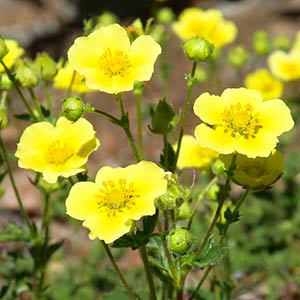Drymocallis pseudorupestris
Drymocallis pseudorupestris var. saxicola
cliff drymocallis, cliff woodbeauty, false rock loving cinquefoil, Rocky Mountain sticky cinquefoil
cliff drymocallis or wood beauty, cliff woodbeauty, Rocky Mountain sticky cinquefoil
elongate.
openly tufted to loosely spaced, (0.3–)0.6–4 dm;
base 1–3 mm diam., ± densely septate-glandular.
0.6–2.5 dm, base 1–2(–3) mm diam., short hairs sparse to moderately abundant, sometimes absent.
glabrate or sparsely to ± densely hairy;
basal (2–)3–16 cm, leaflet pairs (2–)3–4(–5);
terminal leaflet broadly obovate-cuneate to flabellate, 0.2–3(–4) × 0.5–3 cm, teeth single or double, 2–15 per side, apex usually rounded to truncate, sometimes obtuse;
cauline 0–2, reduced, leaflet pairs 2–3.
3–9(–15) cm, sparsely to densely hairy (hairs to 1.5 mm), usually densely peglike-glandular, not bristly;
leaflet pairs (2–)3(–4);
terminal leaflet broadly obovate-cuneate, 0.8–2(–4) × 0.7–2(–3) cm, teeth single or ± double, 3–8(–12) per side.
2–40-flowered, not or ± leafy, open, 1/6–3/4(–4/5) of stem, ± wide, branch angles (10–)20–40(–50)°.
3–20 (proximal to 40) mm, not or sparsely to moderately short-hairy, predominantly septate-glandular.
3–15 (proximal to 20) mm, usually not bristly, short hairs sparse to moderately abundant (sometimes absent).
opening widely;
epicalyx bractlets linear to elliptic, 2–6 × 1–2 mm;
sepals spreading, 4–7(–9) mm, apex acute to obtuse, apiculate;
petals overlapping or not, spreading, cream-white to pale yellow (red-tinged in var. crumiana), narrowly to broadly obovate, 4–12 × 3–11 mm, longer than sepals;
filaments 1–4 mm, anthers 0.7–1.2 mm;
styles thickened, 1–1.5 mm.
(2–)3–12(–20);
hypanthia and sepals not bristly or bristles less than 1 mm;
epicalyx bractlets linear-lanceolate to broadly elliptic, 2–5 × 1–1.5 mm;
sepals 4–6(–7) mm;
petals ± overlapping, not red-tinged, narrowly to broadly obovate, 4–8(–9) × 3–6(–8) mm;
filaments 1–2.5 mm;
styles usually golden brown, rarely reddish.
light brown, 1 mm.
Drymocallis pseudorupestris
Drymocallis pseudorupestris var. saxicola
Varieties 3 (3 in the flora).
Drymocallis pseudorupestris occurs from Alberta and Washington to California and Utah, mostly in montane habitats; it is the species most often associated with rocky habitats, including talus slopes, for which its relatively elongate caudex branches are an obvious adaptation. Vestiture is dominated by abundant septate glands on stems and in the inflorescences. Except for var. pseudorupestris, which occurs only in the northeastern part of the species range, plants are relatively short, usually less than 2.5 dm. Three intergrading varieties accommodate the extremes at the northeastern and southern ends of the range.
(Discussion copyrighted by Flora of North America; reprinted with permission.)
Variety saxicola accommodates the bulk of specimens previously placed in Potentilla glandulosa var. pseudorupestris, minus the extremes at the northeastern and southern ends of the species range. The circumscription here encompasses significant heterogeneity, which might be resolved into additional taxa upon further analysis [for example, the dwarfed high elevation form of P. glandulosa noted by N. H. Holmgren (1997b)]. Some collections from Alberta and Washington have petals as large as those of var. pseudorupestris but are here included in var. saxicola on the basis of stature. Plants from southwestern Idaho and southeastern Oregon combine features of D. lactea and D. pseudorupestris, some being atypically tall (to 5.5 dm) but with the vestiture and saxicolous preference of var. saxicola. In contrast, populations on Steens Mountain, Oregon, including the type of D. pumila Rydberg, have the typical habit of var. saxicola but the vestiture of D. lactea; their optimal placement is unresolved. In California, var. saxicola occurs in the Cascade Range (Mount Lassen, Mount Shasta) and extends sporadically south through the Sierra Nevada to Tulare County, intergrading with var. crumiana and D. lactea.
(Discussion copyrighted by Flora of North America; reprinted with permission.)
1. Stems (1–)2–4 dm, bases (1.5–)2–3 mm diam.; basal leaves (4–)7–16 cm; terminal leaflets (1–)2–3(–4) cm, teeth usually double, (5–)8–15 per side; flowers (5–)10–40; petals 6–12 × 5–11 mm, widely overlapping; filaments 2–4 mm. | var. pseudorupestris |
1. Stems (0.3–)0.6–2.5 dm, bases 1–2(–3) mm diam.; basal leaves (2–)3–9(–15) cm; terminal leaflets 0.2–2(–4) cm, teeth single or ± double, 2–8(–12) per side; flowers 2–12(–20); petals 4–8(–9) × 3–6(–8) mm, not or ± overlapping; filaments 1–2.5(–3) mm | → 2 |
2. Basal leaves: leaflet pairs (2–)3(–4); hypanthia and sepals not bristly or bristles less than 1 mm; short hairs sparse to moderately abundant on stems and pedicels (sometimes absent); styles usually golden brown, rarely reddish. | var. saxicola |
2. Basal leaves: leaflet pairs 3–4(–5); hypanthia and sepals prominently bristly, bristles 1–1.5 mm; short hairs absent or sparse on stems and pedicels; styles usually dark red, rarely golden brown. | var. crumiana |
- Local floras:
BC,
CA,
OR
- Local Web sites:
CalFlora,
CalPhotos,
Flora NW,
PNW Herbaria
WildflowerSearch
iNaturalist (observations)
USDA Plants Database
- LBJ Wildflower Center
- SEINet
- Plants of the World Online
- Encyclopedia of Life
- Wikipedia
- Google Image Search
- Local floras:
BC,
CA,
OR
- Local Web sites:
CalFlora,
CalPhotos,
Flora NW,
PNW Herbaria
WildflowerSearch
iNaturalist (observations)
USDA Plants Database
- LBJ Wildflower Center
- SEINet
- Plants of the World Online
- Encyclopedia of Life
- Wikipedia
- Google Image Search


